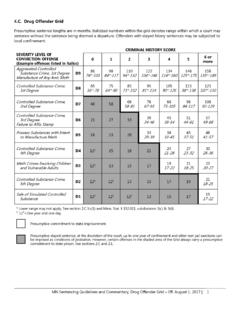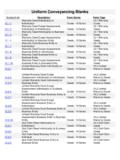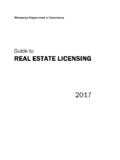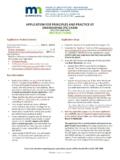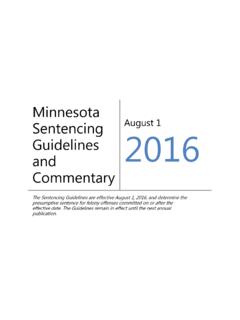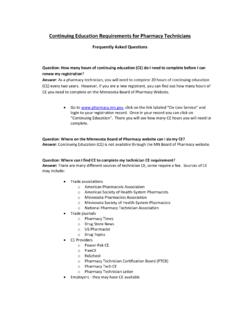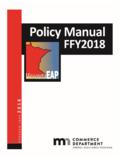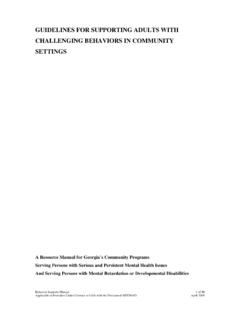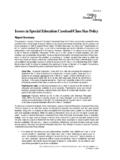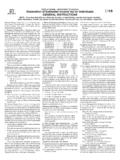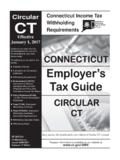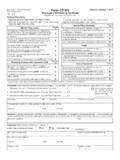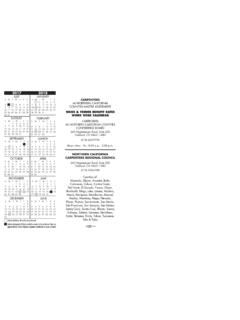Transcription of August 1 2017 - Minnesota
1 Minnesota Sentencing Guidelines and Commentary August 1 2017 These Sentencing Guidelines are effective August 1, 2017 , and determine the presumptive sentence for felony offenses committed on or after the effective date. The Guidelines remain in effect until the next publication. Minnesota Sentencing Guidelines Commission 658 Cedar Street, Suite G-58 Saint Paul, Minnesota 55155 Voice: (651) 296-0144 Website: Email: Persons with hearing or speech disabilities may contact us via their preferred Telecommunications Relay Service. Commission Members Christopher Dietzen, Associate Supreme Court Justice (Retired), Chair and Designee of the Chief Justice of the Minnesota Supreme Court Heidi Schellhas, Vice-Chair and Minnesota Court of Appeals Judge Angela Champagne-From, Public Member Valerie Estrada, Corrections Unit Supervisor, Hennepin County Community Corrections & Rehabilitation Paul Ford, Saint Paul Police Sergeant Caroline Lennon, First Judicial District Judge Cathryn Middlebrook, Chief Appellate Public Defender Peter Orput, Washington County Attorney Tom Roy, Commissioner of Corrections Yamy Vang, Public Member Mark Wernick, Senior Judge, Public Member Commission Staff Nathaniel J.
2 Reitz, Executive Director Kathleen Madland, Research Analyst, Intermediate Linda McBrayer, Management Analyst 4 Jill Payne, Senior Research Analysis Specialist Anne Wall, Senior Research Analysis Specialist Table of Contents 1. Purpose and Definitions .. 1 A. Statement of Purpose and Principles .. 1 B. Definitions .. 2 2. Determining Presumptive Sentences .. 7 A. Offense Severity .. 8 1. General Rule .. 8 2. Theft and Damage to Property; Foreseeable Risk of Bodily Harm .. 8 3. First-Degree Murder .. 8 4. Unranked Offenses .. 8 5. Attempts, Conspiracies, and Other Sentence Modifiers .. 9 B. Criminal History .. 10 1. Prior Felonies .. 12 2. Custody Status at the Time of the Offense .. 18 3. Prior Gross Misdemeanors and Misdemeanors.
3 23 4. Prior Juvenile Adjudications .. 28 5. Convictions from Jurisdictions other than Minnesota .. 30 6. Felony Enhancement Due to Prior Misdemeanor or Gross Misd. Convictions .. 32 7. Determining Offense Levels for Prior Offenses .. 34 C. Presumptive Sentence .. 35 1. Finding the Presumptive Sentence .. 35 2. Presumptive Sentence Durations that Exceed the Statutory Maximum Sentence .. 35 3. Finding the Presumptive Sentence for Certain Offenses .. 36 D. Departures from the Guidelines .. 40 1. Departures in General .. 40 2. Factors that should not be used as Reasons for Departure .. 43 3. Factors that may be used as Reasons for Departure .. 45 E. Mandatory Sentences .. 51 1. In General .. 51 2. Specific Statutory Provisions .. 52 3.
4 Conditional Release .. 54 4. Mandatory Life 54 F. Concurrent/Consecutive Sentences .. 57 1. Presumptive Consecutive Sentences .. 60 2. Permissive Consecutive Sentences .. 63 3. Crime Committed for the Benefit of a Gang .. 66 4. Pre-Guidelines Cases .. 67 G. Convictions for Attempts, Conspiracies, and Other Sentence Modifiers .. 67 1. In General .. 67 2. Attempt or Conspiracy .. 67 3. Solicitation of Juveniles or Mentally Impaired Persons .. 68 4. Conspiracy to Commit a Controlled Substance Offense .. 68 5. Attempt or Conspiracy to Commit Criminal Sexual Conduct in the First or Second Degree .. 68 6. Taking Responsibility for Criminal Acts .. 68 7. Offense Committed in Furtherance of Terrorism .. 68 8. Criminal Sexual Predatory Conduct.
5 69 9. Solicitation or Promotion of Prostitution; Sex Trafficking .. 69 10. Offense Committed for the Benefit of a Gang .. 69 11. Felony Assault Motivated by Bias .. 70 12. Criminal Vehicular Homicide (Death and Qualified Prior Conviction) .. 70 13. Attempt or Conspiracy to Commit First-Degree Murder .. 70 3. Related Policies .. 71 A. Establishing Conditions of Stayed 71 1. Method of Granting Stayed Sentences .. 71 2. Conditions of Stayed Sentences .. 72 B. Revocation of Stayed Sentences .. 74 C. Jail Credit .. 75 1. In General .. 75 2. Applying Jail Credit .. 75 D. 77 E. Presentence Mental or Physical Examinations for Sex Offenders .. 77 F. Military Veterans .. 78 G. Modifications .. 78 1. Policy Modifications .. 78 2. Clarifications of Existing Policy.
6 78 Sentencing Guidelines 79 Sex Offender 81 Drug Offender Grid .. 83 Offense Severity Reference Table .. 85 Severity Level by Statutory Citation .. 104 6. Offenses Eligible for Permissive Consecutive Sentences .. 128 7. Theft Offense List .. 132 8. Targeted Misdemeanor List .. 134 Appendix 1. Mandatory and Presumptive Sentences Reference Table .. 135 Appendix 2. Dangerous Weapons Offense Reference Table .. 137 Appendix 3. Presumptive Sentence Durations that Exceed the Statutory Maximum Sentence Reference Table .. 138 MN Sentencing Guidelines and Commentary | 1 Minnesota Sentencing Guidelines and Commentary 1. Purpose and Definitions A. Statement of Purpose and Principles The purpose of the Sentencing Guidelines is to establish rational and consistent sentencing standards that reduce sentencing disparity and ensure that the sanctions imposed for felony convictions are proportional to the severity of the conviction offense and the offender s criminal history.
7 Equity in sentencing requires that: (a) convicted felons with similar relevant sentencing criteria should receive similar sanctions; and (b) convicted felons with relevant sentencing criteria substantially different from a typical case should receive different sanctions. The Sentencing Guidelines embody the following principles: 1. Sentencing should be neutral with respect to the race, gender, social, or economic status of convicted felons. 2. The severity of the sanction should increase in direct proportion to an increase in offense severity or the convicted felon s criminal history, or both. This promotes a rational and consistent sentencing policy. 3. Commitment to the Commissioner of Corrections is the most severe sanction that can be imposed for a felony conviction, but it is not the only significant sanction available to the court.
8 4. Because state and local correctional facility capacity is finite, confinement should be imposed only for offenders who are convicted of more serious offenses or who have longer criminal histories. To ensure such usage of finite resources, sanctions used in sentencing convicted felons should be the least restrictive necessary to achieve the purposes of the sentence. 2 | Effective August 1, 2017 5. Although the Sentencing Guidelines are advisory to the court, the presumptive sentences are deemed appropriate for the felonies covered by them. Therefore, departures from the presumptive sentences established in the Sentencing Guidelines should be made only when substantial and compelling circumstances can be identified and articulated.
9 B. Definitions As used in these Sentencing Guidelines (or Guidelines ), the following terms have the meanings given. 1. Commitment. Commitment occurs when the offender is sentenced to the custody of the Commissioner of Corrections. 2. Concurrent Sentence. When the court orders sentences to be concurrent, the court is ordering that multiple sentences be served at the same time. 3. Consecutive Sentence. When the court orders sentences to be consecutive, the court is ordering that multiple sentences be served one after the other in the manner described in section 4. Criminal History Score. The criminal history score is comprised of criminal history factors detailed in section The horizontal axis on the applicable grid represents the offender s criminal history score.
10 5. Departure. A departure is a pronounced sentence other than that recommended in the appropriate cell on the applicable Grid, including a stayed or imposed gross misdemeanor or misdemeanor sentence. a. Dispositional Departure. A dispositional departure occurs when the court orders a disposition other than that recommended in the Guidelines. (1) Aggravated Dispositional Departure. An aggravated dispositional departure occurs when the Guidelines recommend a stayed sentence but the court pronounces a prison sentence. MN Sentencing Guidelines and Commentary | 3 (2) Mitigated Dispositional Departure. A mitigated dispositional departure occurs when the Guidelines recommend a prison sentence but the court stays the sentence.
